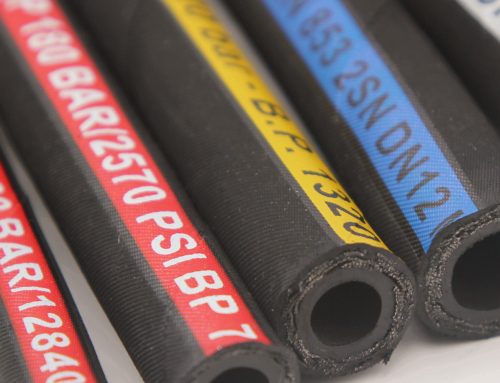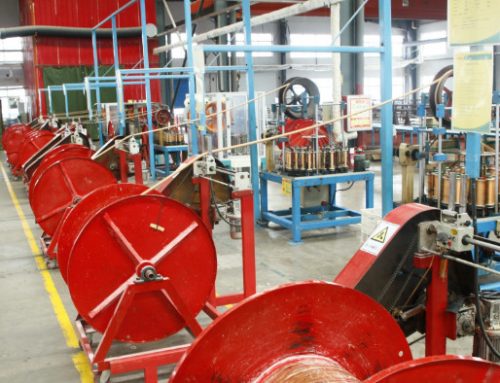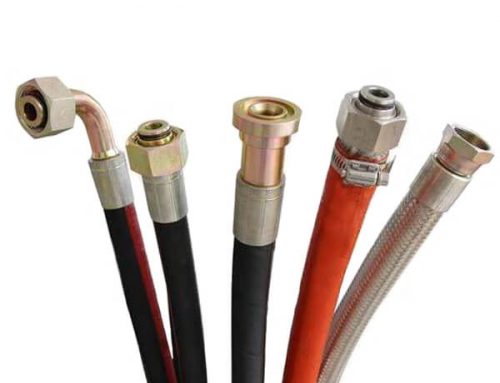A hydraulic hose is a crucial component in hydraulic systems, playing a vital role in transmitting fluid power within machinery and equipment. It is designed to withstand high pressure and carry hydraulic fluids between different components, such as pumps, valves, cylinders, and motors.
A hydraulic hose is a flexible hose made of rubber, thermoplastic, or stainless steel, designed to carry fluid within a hydraulic system. It plays a vital role in transmitting hydraulic power from one component to another. This article will explore the various types, standards, sizes, materials, fittings, assembly, and applications of hydraulic hoses.
TYPES
- BRAIDED HOSE
This type of hose consists of a synthetic or natural rubber inner tube, reinforced with one or more layers of braided textile or steel wire. It offers excellent flexibility and high resistance to abrasion.
When it comes to reliable and durable hose options, braided hoses are a top choice. These versatile hoses have gained popularity across various industries for their exceptional strength and flexibility. Whether you need a hose for industrial applications, automotive use, or even in your home, a braided hose is designed to meet your needs.
The key feature of a braided hose lies in its construction. It consists of multiple layers of reinforcement, typically made of high-strength materials such as stainless steel or synthetic fibers. This braiding provides added strength and stability to the hose, making it resistant to pressure, abrasion, and even extreme temperatures.
One of the significant advantages of using a braided hose is its ability to handle high-pressure applications with ease. The reinforcement layers ensure that the hose can withstand substantial internal pressures without compromising its integrity. This makes it an ideal choice for hydraulic systems, pneumatic equipment, and other demanding environments where reliable performance is crucial.
Furthermore, the braided construction also enhances the flexibility of the hose. It allows for easy maneuverability around tight corners and obstacles without kinking or restricting flow. This flexibility makes it easier to install and ensures smooth operation in various applications.
Braided hoses are widely used in industries such as manufacturing, construction, automotive, aerospace, and more. They find application in conveying fluids like water, oil, gas, chemicals while maintaining optimal flow rates and preventing leaks or bursts.
- MULTI-SPIRAL HOSE
Multi-spiral hoses have four or six layers of high-tensile steel wire reinforcement, providing enhanced strength and durability. They are suitable for high-pressure applications.
Introducing the Multi-Spiral Hose: The Ultimate Solution for Your Hydraulic Needs
When it comes to hydraulic systems, having a reliable and efficient hose is crucial. That’s where the Multi-Spiral Hose comes into play. Designed to withstand high-pressure applications and provide exceptional flexibility, this innovative hose is revolutionizing the industry.
The Multi-Spiral Hose is engineered with multiple layers of reinforcement, ensuring maximum strength and durability. Its unique spiral construction allows for increased flexibility without compromising on performance. Whether you’re dealing with heavy machinery or demanding industrial applications, this hose can handle it all.
One of the key advantages of the Multi-Spiral Hose is its ability to maintain consistent pressure throughout its length. This ensures smooth operation and minimizes pressure drops, resulting in improved overall system efficiency. Additionally, its superior resistance to abrasion and wear guarantees a longer lifespan compared to traditional hoses.
Versatility is another standout feature of the Multi-Spiral Hose. It can be used in a wide range of industries such as construction, mining, agriculture, and more. From transferring hydraulic fluids to powering machinery, this hose delivers exceptional performance in various applications.
Furthermore, the Multi-Spiral Hose offers ease of installation and maintenance. Its flexible design allows for effortless routing around obstacles while providing a secure connection between components. With proper care and regular inspections, this hose will continue to deliver reliable performance over an extended period.
- LOW-PRESSURE HOSE
Low-pressure hoses are designed for applications with operating pressures lower than 300 psi. They are commonly used in general-purpose hydraulic systems.
Our low-pressure hose is engineered to withstand a wide range of pressures, making it suitable for various applications. From pneumatic systems to fluid transfer, this versatile hose ensures optimal performance and durability.
Designed with precision and manufactured using top-grade materials, our low-pressure hose guarantees exceptional reliability and longevity. Its flexible construction allows for easy installation and maneuverability, while maintaining excellent resistance against abrasion and wear.
- STAINLESS STEEL WIRE-BRAIDED HOSE
These hoses have a stainless steel wire braid reinforcement, offering increased strength and resistance to corrosion. They are ideal for applications in harsh environments.
The stainless steel wire-braided hose is constructed with a flexible inner core made of synthetic rubber or PTFE (polytetrafluoroethylene) material. This inner core is then reinforced with multiple layers of high-quality stainless steel wires, tightly braided together. The result is a robust and highly durable hose that can handle extreme temperatures, corrosive chemicals, and heavy-duty applications.
One of the key advantages of the stainless steel wire-braided hose is its exceptional strength and flexibility. The braiding not only provides added reinforcement but also allows for greater flexibility, enabling easy maneuverability even in tight spaces. This makes it ideal for use in industries such as automotive, aerospace, oil and gas, pharmaceuticals, food processing, and many more.
Furthermore, this type of hose offers excellent resistance to abrasion, puncture, and external damage. It can withstand harsh environmental conditions without compromising its structural integrity or performance. Additionally, the stainless steel construction ensures resistance to corrosion caused by exposure to chemicals or moisture over time.
- THERMOPLASTIC HYDRAULIC HOSE
Thermoplastic hoses are made of synthetic materials like nylon, polyethylene, or polyurethane. They have excellent resistance to chemicals, high flexibility, and a wide temperature range.
One of the standout advantages of thermoplastic hydraulic hoses is their lightweight construction. Compared to their rubber counterparts, they are significantly lighter in weight, resulting in reduced fuel consumption and increased overall efficiency. This makes them ideal for applications where weight reduction is crucial, such as mobile equipment or aerospace industries.
Furthermore, thermoplastic hydraulic hoses offer excellent chemical resistance properties. They are highly resistant to oil, fuels, solvents, acids, and other corrosive substances commonly encountered in industrial environments. This resistance ensures longevity and reliability even in the most demanding applications.
Another noteworthy feature of these hoses is their exceptional flexibility. The thermoplastic material allows for greater bendability without compromising performance or integrity. This flexibility enables easier installation in tight spaces or complex routing configurations while minimizing the risk of kinks or bends that could impede fluid flow.
- WATERBLAST HOSE
Waterblast hoses are specifically designed for high-pressure water jetting applications. They can withstand extreme pressure and provide efficient cleaning and cutting capabilities.
The Waterblast Hose is built to withstand high pressures, making it ideal for a wide range of industrial applications such as surface preparation, cleaning, and hydro-demolition. Its reinforced construction ensures maximum strength and durability, allowing it to withstand the harshest conditions without compromising performance.
With its advanced design and superior materials, the Waterblast Hose offers exceptional resistance against abrasion, chemicals, and UV rays. This means that you can rely on this hose to deliver consistent performance even in harsh environments.
Whether you’re working in construction, mining, or any industry that requires high-pressure water blasting, the Waterblast Hose is your go-to solution. Its flexibility allows for easy maneuverability while its high burst pressure rating ensures safe operation under extreme conditions.
STANDARD
- SAE STANDARDS
The Society of Automotive Engineers (SAE) has established standards for hydraulic hoses, fittings, and assemblies. These standards ensure compatibility and performance across different manufacturers.
- EN STANDARDS
The European Norm (EN) standards are widely adopted in Europe and ensure the quality and safety of hydraulic hoses. They cover aspects such as dimensions, performance, and testing requirements.
HOSE SIZE
Hydraulic hoses come in various sizes, which are specified by their inside diameter (ID) and outside diameter (OD). Common sizes range from 1/4 inch to 2 inches, with larger sizes available for specialized applications.
MATERIAL
- HYDRAULIC RUBBER HOSE
Rubber hoses are the most common type of hydraulic hoses. They offer good flexibility, high strength, and resistance to abrasion, oil, and weather conditions.
- HYDRAULIC THERMOPLASTIC HOSE
Thermoplastic hoses are lightweight, flexible, and have excellent chemical resistance. They are commonly used in applications where low temperature or high-pressure conditions are present.
- TEFLON (PTFE) HOSE
Teflon hoses have a PTFE inner tube, providing excellent chemical resistance and a wide temperature range. They are suitable for applications involving aggressive fluids.
- STAINLESS STEEL HOSE
Stainless steel hoses are used in applications that require high temperature resistance and resistance to corrosion. They are commonly used in extreme environments or for conveying aggressive fluids.
HYDRAULIC HOSE FITTINGS & ASSEMBLY
Hydraulic hose fittings are used to connect hoses to hydraulic systems. They come in various types, including straight, elbow, tee, and cross fittings. The assembly process involves cutting the hose to the desired length, attaching the fittings, and crimping them securely to create a leak-free connection.
APPLICATION
Hydraulic hoses find applications in various industries, including:
- CONSTRUCTION
Hydraulic hoses are used in construction machinery such as excavators, loaders, and cranes to transmit hydraulic power for lifting, digging, and other operations.
- AGRICULTURE
Hydraulic hoses are essential in agricultural equipment like tractors and harvesters. They enable the operation of hydraulic systems for tasks like lifting, steering, and controlling attachments.
- MINING
Mining equipment relies on hydraulic hoses for functions like drilling, crushing, and conveying materials. These hoses withstand harsh conditions and high-pressure environments.
- MANUFACTURING
Hydraulic hoses are used in manufacturing processes such as injection molding, metal forming, and robotics. They facilitate the operation of hydraulic machinery and control systems.
- AEROSPACE
Hydraulic systems are crucial in aircraft for functions like landing gear operation, wing control, and braking. Hydraulic hoses ensure the transmission of hydraulic power in these applications.
- AUTOMOTIVE
Hydraulic hoses are present in vehicles for various functions, including power steering, braking, and suspension systems. They enable the smooth and reliable operation of these systems.
- MARINE
Hydraulic hoses are used in marine applications for steering, winches, and lifting systems. They withstand saltwate
HOW TO CHOOSE RIGHT HYDRAULIC HOSES FOR YOUR PROJECT
When selecting a hydraulic hose, consider factors such as operating pressure, temperature, fluid compatibility, flexibility, and environmental conditions. It is essential to consult industry standards, manufacturer specifications, and seek professional advice to ensure the right hose for the specific application.
When it comes to choosing the right hydraulic hoses for your project, it is crucial to make an informed decision. The performance and safety of your hydraulic system depend on selecting the correct hoses that can withstand the specific demands of your project.
To ensure you choose the right hydraulic hoses, there are several factors you need to consider. Firstly, evaluate the operating pressure and temperature requirements of your system. Different projects have varying pressure and temperature ranges, so it is essential to select hoses that can handle these conditions without compromising performance.
Next, assess the compatibility of the hose materials with the fluid being conveyed. Hydraulic systems use different types of fluids such as oil, water, or synthetic fluids. It’s vital to choose hoses that are compatible with the specific fluid used in your project to prevent any chemical reactions or degradation.
Another critical factor is hose size and length. The size should be determined by considering flow rate requirements and pressure drop limitations within your system. Additionally, ensure that you select a hose length that provides sufficient flexibility without excessive slack or tension.
Furthermore, consider environmental factors such as abrasion resistance and exposure to chemicals or UV rays. If your project involves working in harsh conditions or exposed environments, opt for hoses with additional protective features like abrasion-resistant covers or UV stabilizers.
Lastly, don’t forget about industry standards and certifications. Ensure that the hydraulic hoses you choose comply with relevant industry standards such as SAE (Society of Automotive Engineers) specifications for optimal performance and safety.
SOMAXFLEX – THE RELIABLE HYDRAULIC HOSE MANUFACTURER IN CHINA
Hydraulic hoses are essential components in hydraulic systems, enabling the transmission of hydraulic power. Understanding the different types, standards, sizes, materials, fittings, assembly, and applications of hydraulic hoses is crucial for selecting the appropriate hose for a specific purpose. By considering various factors, one can ensure the safe and efficient operation of hydraulic systems.



